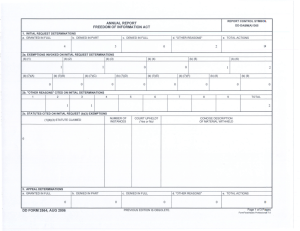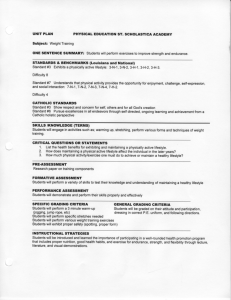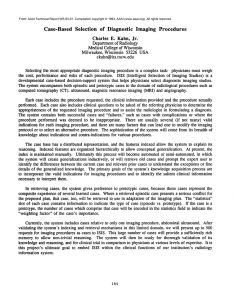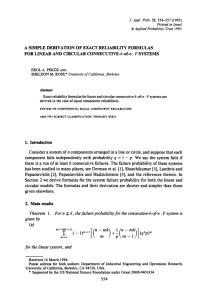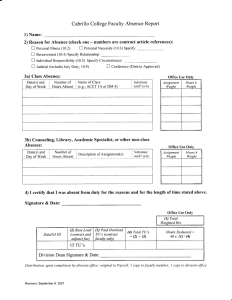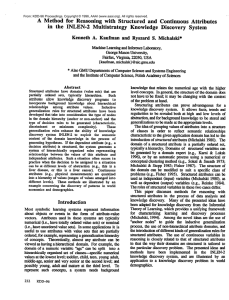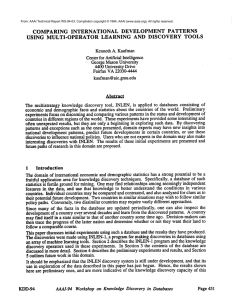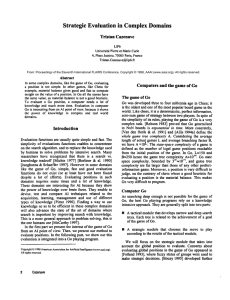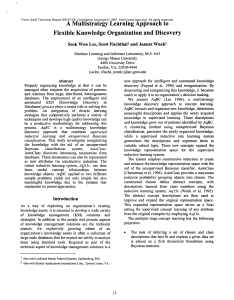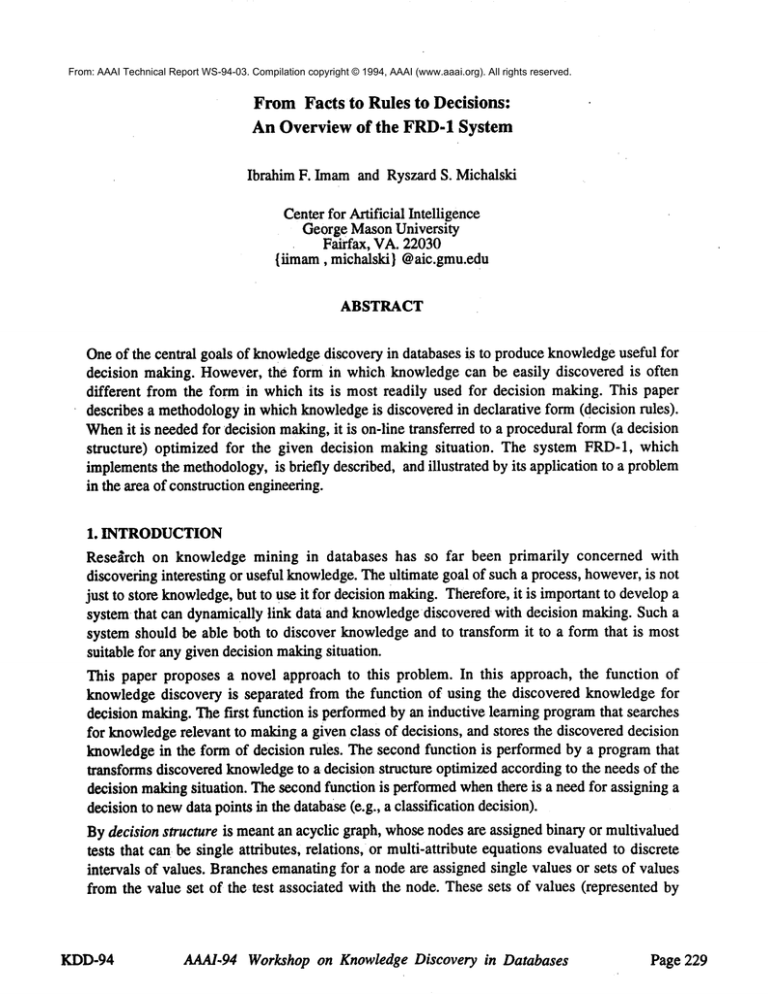
From: AAAI Technical Report WS-94-03. Compilation copyright © 1994, AAAI (www.aaai.org). All rights reserved.
From Facts to Rules to Decisions:
An Overview of the FRD-1 System
Ibrahim F. Imamand Ryszard S. Michalski
Centerfor Artificial Intelligence
George MasonUniversity
Fairfax, VA. 22030
{iimam, michalski} @aic.gmu.edu
ABSTRACT
Oneof the central goals of knowledgediscovery in databases is to produce knowledgeuseful for
decision making. However, the form in which knowledge can be easily discovered is often
different from the form in which its is most readily used for decision making. This paper
describes a methodologyin which knowledgeis discovered in declarative form (decision rules).
Whenit is neededfor decision making,it is on-line transferred to a procedural form (a decision
structure) optimized for the given decision making situation. The system FRD-1, which
implementsthe methodology,is briefly described, and illustrated by its application to a problem
in the area of construction engineering.
1.
INTRODUCTION
Rese~lrch on knowledge mining in databases has so far been primarily concerned with
discovering interesting or useful knowledge.Theultimate goal of such a process, however,is not
just to store knowledge,but to use it for decision making.Therefore, it is important to develop a
system that can dynamically link data and knowledgediscovered with decision making. Such a
system should be able both to discover knowledgeand to transform it to a form that is most
suitable for any given decision makingsituation.
This paper proposes a novel approach to this problem. In this approach, the function of
knowledgediscovery is separated from the function of using the discovered knowledge for
decision making.The first function is performedby an inductive learning programthat searches
for knowledgerelevant to makinga given class of decisions, and stores the discovered decision
knowledgein the form of decision rules. The second function is performed by a program that
transforms discovered knowledgeto a decision structure optimized according to the needs of the
decision makingsituation. The second function is performedwhenthere is a need for assigning a
decision to newdata points in the database(e.g., a classification decision).
By decision structure is meant an acyclic graph, whosenodes are assigned binary or multivalued
tests that can be single attributes, relations, or multi-attribute equations evaluated to discrete
intervals of values. Branchesemanatingfor a node are assigned single values or sets of values
from the value set of the test associated with the node. These sets of values (represented by
KDD-94
AAAI.94 Workshop on Knowledge Discovery in Databases
Page 229
internal disjuction) are mutuallydisjoint; their union spans all the possible values (outcomes)
the test. Terminalnodes (leaves)are assigned single decisions, or sets of (alternative) decisions
with correspondingprobabilities. Leavescan also be assigned a special value "7", whichstands
for "do not know." A decision structure becomesa decision tree whennodes are assigned single
attributes, branches are assigned single values (test outcomes), and leaves are assigned single
decisions.
The paper briefly describes the proposed methodology, and shows how the system tailors
decision structures to different decision makingsituations. The methodologyis illustrated by a
problemof determining a decision Structure for the wind bracing design in different decision
makingsituations. These situations differ in that they mayrequire 1) a decision structure that
avoids someunavailable or costly test; 2) assigning an "unknown"decision in a situation when
there is insufficient information, 3) informing the user what newinformation is neededin order
to assign a specific decision with high certainty, and 4) alternative decisions with an estimate of
the probability of their correctness, whenthe needed information can not be provided. A more
detailed description of the methodologyand results of various comparativestudies are presented
in (Imamand Michalski, 1994).
2. AN OVERVIEWOF THE FRD.1 METHODOLOGY
The proposed system consists of two subsystems. The first subsystem searches for useful
knowledgein the data. Knowledge
is represented in the form of decision rules, whichare a form
of declarative knowledgerepresentation. Such a representation makesno restrictions on the order
in which different tests are applied and is relatively easy to modifyand improve. To discover
knowledgein data, the system employsthe inductive learning programAQ15/C(Michalski, et al,
1986). Whenthere is a need to appIy the discoverd knowledgeto new data for the purpose of
decision making, the AQDT-1
system is used to transform the decision rules into a decision
stuctu’re that is tailored to the given decision makingsituation (Imam& Michalski, 1993). Figure
1 showsan architecture of the FRD-1 methodology.
AQXS/c
A~VT-1
Discovering rules from database
m m The decision making process
Figure 1: Anarchitecture of the FRD-1system.
It is assumedthat the database is not static, but is regularly updated. A decision makingproblem
arises whenthere is a case or a set of cases to whichthe systemhas to assign a decision based on
the knowledgediscovered. Each decision makingcase is defined by a set of attribute values.
Someattribute values maybe missing or unknown.A new decision structure is obtained such
Page230
AAA1-94 Workshop on Knowledge Discovery in Databases
KDD-94
that it suits the given decision makingproblem. Thelearned decision structure associates the new
set of cases with the proper decisions.
3.
SUBSYSTEM I:
DERIVING KNOWLEDGESFROMDATA
The first subsystem applies the AQ15/Cinductive learning programto discover knowledgesin
the data. The program creates decision rules from examples of decisions, using the STAR
methodology(Michalski, 1986),The simplest algorithm based on this methodology, called AQ,
starts with a "seed" exampleof a given decision class, and generates a set of the most general
conjunctivedescriptions of the seed (alternative decision rules). Sucha set is called the "star"
the seed example.Thealgorithm selects from the star a description that optimizes a user-defined
criterion reflecting the needs of the problemdomain.If the criterion is not def’med,the program
uses a default criterion that selects the description that covers the largest numberof positive
examples(to minimizethe total numberof rules needed) and, if there is a tie, it selects the
description that involves the smallest numberof attributes.
If the selected description does not cover all examplesof a given decision class, a newseed is
selected from uncoveredexamples, and the process continues until a complete class description
is generated. The algorithm can work with few examples or with many examples. It can
optimizethe description accordingto a variety of easily-modifiable hypothesis quality criteria.
AQ15/Ccan generate decision rules that represent either characteristic or discriminant concept
descriptions, dependingon the settings of its parameters. A characteristic description states
properties that are true for all objects in the concept. The simplest characteristic concept
description is in the form of a single conjunctive rule (in general, it can be a set of such rules).
The most desirable is the maximalcharacteristic description, that is, a rule with the longest
condition part which states as manycommonproperties of objects of the given class as can be
determined. Adiscriminant description states properties that discriminate a given concept from a
fixed set of other ("context") concepts. The most desirable is the minimal discriminant
descriptions, that is a rule with the shortest condition part.
To illustrate the AQ15/Crule learning, let us consider a problem of determining a decision
structure for windbracing design (Arciszewski, et al, 1992). Thewind bracing data contains four
decision classes representing different categories of the buildings: high (C1), medium(C2),
(C3) and infeasible (C4). Examplesof design have been expressed in terms of seven attributes
that are shownin Table 1. The data consists of 335 examples, 220 randomlyselected examples
were used as training examples for learning a concept description and the remaining 115
examplesfor testing.
In the experiment, AQ15/Cwas applied to the training examples to obtain rules from the data.
Figure 2 showsthe discovered rules and their strengths. The t-weight (total-weight) of a rule for
some class is the numberof examples of that class covered by the rule. The u-weight (uniqueweight) of a rule for someclass is the numberof examplesof that class coveredonly by this rule.
KDD-94
AAAI.94 Workshop on Knowledge Discovery in Databases
Page 231
xi
:?
¯ x2
X3
X4
x5
x6
numberof ’stories
bay length
¯ windintensity
numberof oints
numberof bays
numberof vertical trusses
miml~erof horizontal trusses
Table 1: The symbolicattributes of the windbracing data and their full names.
CI : High Buildings
1 [xl=l][x5=lv2l[x6=l][x7=lv2v3]
2 [xl=l][x2=2][x5=lv2][x6=l]
(t: 18, u:09)
(t: 10, u:O2)
C2: MediumBuildings
1 [xl =2v3v4] [x4=3] [x5=2v3] [x7=2v3]
2 [xl -- 2 v 3 v 4 v 5] [x3 = 1] [x5 = 2 v 3] Ix6 = 1] [x7 = 1 v 2 v 3]
(t:28, u:02)
(t:27, u:10)
Figure 2: A sample of rules discovered by AQ15for the wind bracing data.
4. SUBSYSTEMH: DRIVING DECISION STRUCTURE FROM DECISION RULES
AQDT-1
generates decision structures from decision rules by determining the "best" test (here,
attribute) at each step of the decision process. Theattribute is selected by analyzing the rules.
The methodaims at producing decision structures with the minimumnumberof nodes and/or the
minimumcost (where the "cost" was defined as the total cost of classifying unknownexamples,
given the cost of measuringindividual attributes and the expected probability distribution of
examplesof different decision classes). For moredetailed explanation of the algorithm and its
comparison with other systems, see Imam& Michalsld (1993).
AQDT-1
chooses attributes on the basis of an attribute utility criterion, which combinesthree
elementary criteria: 1) disjointness--that captures the attribute effectiveness in discriminating
amongdecision rules of different decision classes, 2) dominance--that measures the attribute
relevance by counting the numberof rules that contain the attribute, and 3) extent --that
measuresthe numberof different attribute values present in the rules.
Table 2 shows the disjointness and dominance values for each attribute. The disjoinmess
criterion is selected as the first criterion for selecting tests to be nodesin the decision tree. Figure
3 shows a decision structure learned in the default setting of FRD-1parameters from AQ15/C
rules. It has 5 nodes and 9 leaves. Testing this decision structure against 115 testing examples
results in 102 examples matched correctly and 13 examples mismatched. For comparison, when
the C4.5 system (Quinlan, 90) for learning decision trees from exampleswas applied to the same
Page 232
AAM-94 Workshop on Knowledge Discovery in Databases
KDD-94
set of examples. It produceda decision structure with 17 nodes and 43 leaves. The decision tree
matchedcorrectly 97 and mismatched18 examples.
I
]xI
,:Atti~,bU
,t$ Disjointn~ 5
’,:A~tributeDomln~ce.~ ’ 45,
I x2
3:
341
]
Attrlbut~=. ....
i.
x3
0 ’!
42~
x6~,~~, x
x4
11
33~
.....
3 ¯
40’
18
I’
3
54
30
Table 2: Initial values of selection criteria for each attribute of the windbracing problem.
xl
xl
Complexity
I
I
No. of nodes: 5
No. of leaves: 9
Figure 3: A decision structure learned by AQDT-1
from AQ15/(2wind bracing rules.
$. SPECIAL CASES IN DECISION MAKING
Decision making situations can vary in several respects. In some situations, a complete
informationabouta data item is available (i.e., valuesof all attributes are specified), in others the
information maybe incomplete. To reflect such differences, the user specifies a set of parameters
that control the process of creating a decision structure from decision rules. FRD-1provides
several features for handling different decision making problems: 1) generates a decision
structure that tries to avoid unavailable or costly attributes (tests); 2) generates "unknown"
leaves
in situations wherethere is insufficient informationfor generating a completedecision structure;
3) provides the user with the most likely decision whenmeasuringa required test is impossible;
4) provides alternative decisions with an estimate of the likelihood of their correctness, whenthe
needed information can not be provided.
Avoidingunavailable attributes. The cost of an attribute refers to the cost of measuringthat
attribute during the process of decision making. Sometimesan attribute cannot be measuredat
all, in which case cost is assumedto be "infinite". Quinlan (1990) proposeda methodto handle
the "unknownattribute value"¯ problem, in which the relative probability of an example
belonging to different classes is used to determine class membership.FRD-1provides a newway
of solving this problem.Specifically it attempts to generate a decision structure that either does
not contain the unavailableattribute or shifts it to the bottomof the decision structure.
For example, assumethat the value of xl is unavailable for a given data item. FRD-1generates
the decision structure shownin Figure 4. Assumenowthat x6 can be measured but has higher
KDD-94
AAAI-94 Workshop on Knowledge Discovery in Databases
Page 233
cost than other attributes. In this case, AQDT-1
generates the decision structure shownin Figure
5.
Completenessof Decision Structure: Another decision making problems that can be solved by
FRD-1is whenthe testing exampledoes not match any branch in the structure. To explain this
problem, let us assumethat the value of xl is unavailable for a given decision makingproblem.
Thegenerated decision structure in this case is not complete(in Figure 4, the dark lines only).
Assumethat the available information is (xl = 1; x2 = 2; x3 = 2; x5 = 2; x6 = 1; x7 = 2). In this
case, decision structure indicates likely decisions of whichan estimate of their likelihood. The
estimate reflects the frequencyof classes whenthe data points satisfy the conditions on the path
from the root to the leaf. Details on howto calculate these frequencies are in (Imam& Michalski,
1994).
x2
x7
"-.4
’,,2
/Cl~
1C2}
x3
~
)
~C~
)
II Complexity
I No"°fn°des: 5
I No.of leaves: 7
Theratio present the likelyhood of each decision at the given leave.
Figure4: A decision structures learned wherex 1 is unavailable.
The leaf weight for a class C shownin figure 4 is calculated as the sumof the t-weights of the
rules gatisfied by conditions in the decision structure fromthe root to the given leaf divided over
the sum,of the t-weightsof all rules of the class C. This is an estimate of the weightof this leaf in
assigning the decision class C .to an event satisfying the condition of the path fromthe root to the
leaf. The weight of the leaf for class C is viewedas a likelihood of an event satisfying the
conditions on the path to the leaf.
xl
t,C1) k.C3)
x2h_~-,)
k-C3fl
k~C2") k’C3") I Complexity
I No.of nodes: 9 I
¯
[ No.of leaves: 14 [
The dotted lines indicate situation in whichx6 can be evaluated
Figure5: A decision structures learned with high cost of x6.
Page 234
AAAI-94 Workshop on Knowledge Discovery in Databases
KDD-94
6. CONCLUSION
The paper outlined a methodologyfor discovering decision rules from data and transfering them
to decisions structures most suitable for any particular decision making situation. The
preliminary experiments showthat it is easier to generate a decision structure tailored to any
given decision makingproblemfrom rules than to modify a decision structure once created from
examples. FRD-1has several novel features including: provides a methodfor creating decision
structure from rules; to generate nodes with approximate decisions in situations whenthere is
insufficient information to generate a complete decision structure. These features are were
illustrated in an experiment concerned with determining a decision structure for wind bracing
design.
ACKNOWLEDGMENTS
The authors thank Eric Bloedornand KenKaufmanfor their useful commentson the earlier draft
of the paper.
This research was conducted in the Center for Artificial Intelligence at George Mason
University. The Center’s research is supported in part by the AdvancedResearch Projects
Agencyunder the grant No. N00014-91-J-1854, administered by the Office of Naval Research,
and under the grant No. F49620-92-J-0549,administered by the Air Force Office of Scientific
Research, in part by the Office of Naval Research under grant No. N00014-91-J-1351,and in
part by the National Science Foundationunder grant No. IRI-9020266.
REFERENCES
Arciszewski, T, Bloedorn, E., Michalski, R., Mustafa, M., and Wnek, J., (1992).
"Constructive Induction in Structural Design", Report of Machine Learning and Inference
Labratory, MLI-92-7,Center for Artificial Intelligence, GeorgeMasonUniversity.
Imam,I.F. and Michalski, R.S., (1993). "Learning Decision Structures from Decision Rules:
method and initial results from a comparative study", in Journal of Intelligent Information
Systems JIIS, Vol. 2, No. 3, pp. 279-304, Kerschberg, L., Ras, Z., & Zemankova,M. (Eds.),
Kluwer Academic Pub., MA.
Imam, I.F. and Michalski, R.S., (1994), "From Data to Knowledge to Optimal Decision
Structures: A Methodology and Expriments", Report of Machine Learning and Inference
Labratory, MLI-94-xx,Center for AI, GeorgeMasonUn.. (to appear)
Michalski, R.S., Mozetic, I., Hong, J. & Lavrac, N., (1986). "The Multi-Purpose Incremental
Learning System AQ15and Its Testing Application to Three Medical Domains", Proceedings of
AAA/-86,(pp. 10441-1045),Philadelphia, PA.
KDD-94
AAAI-94 Workshop on Knowledge Discovery in Databases
Page 235
Quinlan, J. R. (1990). "Probabilistic decision structures," in Y. Kodratoff and R.S. Michalski
(Fzls.), MachineLearning: An Artificial Intelligence Approach,Vol. III, San Mateo, CA,Morgan
KaufmannPublishers, (pp. 63-111), June.
Page 236
AAAI-94Workshop on Knowledge Discovery in Databases
::
T

